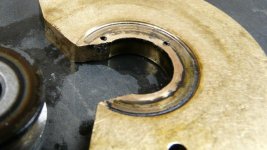turbominivan
New member
- Joined
- May 5, 2013
- Messages
- 108
i have an HX-40 / HT3B twin set up. up until tonight i have had the HX-40 ungated (gate held shut). ive boosted up to 94psi that i have seen but im sure it can do more (not that i need it to....)
anyways, my issue is that with that kind of boost and an ungated smaller turbo, i believe the large turbo is forcing enough volume/pressure of its own into the smaller hx-40, causing the hx-40 to get over spun, and/or the compressor is being 'pushed' against the thrust bearing causing wear and then eventually a slight oil leak at the worn thrust bearing area (not nearly enough for a run away). ive replaced the thrust bearing on the HX-40 3 times now. each time it shows heavy wear. im using 360* thrust bearings.
so tonight what i did was put a factory style waste gate actuator on the hx-40 set to open at 30psi. i was planing to run the vacuum line to it from the PRIMARY turbo so as the primary begins to boost, the gate on the HX will open and take some stress off of it.
i havent taken the car for a drive yet (this is in a hot rod), but im assuming already that to gate it for 30psi off the primary, its a bit too late. im thinking that by the time the primary is making 30psi, the over spinning is already in full swing.
so for the questions....
should i lengthen the actuator arm to open off the primary at say 15psi,
or should i leave it gated at 30psi and have it actuated off the manifold pressure at 30psi?
from what i see, the HT3B seems to begin waking up when the manifold pressure is between 10-15psi.
with the actuator set to open at 30 as it now sits, my thinking leads me to lean toward using the manifold pressure to open it, not the primary.
would i be wise in this? or should i lengthen the arm and use the primary pressure at say 15psi?
would using the primary to actuate the gate cause fluttering or overly rapid responses??
or should i use the the actuators vacuum port at all? and just let the exhaust pressure push the gate open and regulate itself?
im not so much trying to lower boost as i am just trying to keep thrust bearings alive.
ignore the oil drip/stain just below the HT3B feed pipe. that was from greasing the flange when putting things back together



anyways, my issue is that with that kind of boost and an ungated smaller turbo, i believe the large turbo is forcing enough volume/pressure of its own into the smaller hx-40, causing the hx-40 to get over spun, and/or the compressor is being 'pushed' against the thrust bearing causing wear and then eventually a slight oil leak at the worn thrust bearing area (not nearly enough for a run away). ive replaced the thrust bearing on the HX-40 3 times now. each time it shows heavy wear. im using 360* thrust bearings.
so tonight what i did was put a factory style waste gate actuator on the hx-40 set to open at 30psi. i was planing to run the vacuum line to it from the PRIMARY turbo so as the primary begins to boost, the gate on the HX will open and take some stress off of it.
i havent taken the car for a drive yet (this is in a hot rod), but im assuming already that to gate it for 30psi off the primary, its a bit too late. im thinking that by the time the primary is making 30psi, the over spinning is already in full swing.
so for the questions....
should i lengthen the actuator arm to open off the primary at say 15psi,
or should i leave it gated at 30psi and have it actuated off the manifold pressure at 30psi?
from what i see, the HT3B seems to begin waking up when the manifold pressure is between 10-15psi.
with the actuator set to open at 30 as it now sits, my thinking leads me to lean toward using the manifold pressure to open it, not the primary.
would i be wise in this? or should i lengthen the arm and use the primary pressure at say 15psi?
would using the primary to actuate the gate cause fluttering or overly rapid responses??
or should i use the the actuators vacuum port at all? and just let the exhaust pressure push the gate open and regulate itself?
im not so much trying to lower boost as i am just trying to keep thrust bearings alive.
ignore the oil drip/stain just below the HT3B feed pipe. that was from greasing the flange when putting things back together



Last edited:


